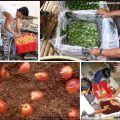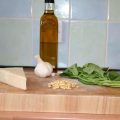This idea of making powdered tomato is just easy to make in your kitchen. The resulting product is red in color and smells and tastes like fresh tomatoes. To cook, mix with water as needed.

How to make powdered tomatoes easily at home
Procedure:
1. Dip the tomatoes in boiling water for a minute.
2. Dip in 500 ppm solution of sodium metabisulfite for 2 minutes.
3. Dry in the oven at 54°C for 9 hours or until its moisture goes down to 7.5%.
4. Pulverize the dried tomatoes in a pestle.
Source: Selected R&D Completed Projects, NSTA 1982







Making powdered tomato is a good idea; especially here in the Philippines where tomatoes becomes so abundant during the harvest months of January to March. I will always remember when I saw fields of tomatoes while driving in Pangasinan. Nobody was harvesting these, and these were being left on the fields to rot. When I asked a local why; he answered that it would cost more money to pay a laborer to pick tomatoes than what the harvested tomatoes would fetch on the market, even on the retail. This anecdote just shows that during a bumper harvest, without post harvest facilities, it would just not translate to more income for the farmer.
The government tried to introduce tomato ketchup, juice, puree, sauce and paste making, canning and pouch (retort) manufacturing; but for whatever reasons, it just didn’t took-off. Now, powder tomato is also a good product, as well as lycopene extraction. But I have some comments on your suggested processing.
First is the length of time you put it in the oven, 9 long hours. That is okay IF you don’t pay so much for electricity in this country. Mining for bitcoin would be much cheaper compared to this. It would be more practical to buy powdered tomato than producing it with this system, even if you own the tomatoes to begin with.
Second, you mentioned “easy to make”. Apparently, the technology being presented was designed for farmers and housewives; farmers who want to augment their income, and housewives who has a lot of time to spare.
There is nothing easy about 1) where to buy or access sodium metabisulfite; 2) can one access it in non-commercial quantities; 3) how do one measure 500 ppm (parts per million); what instrument to use, where to access this?; 4) how do you measure if moisture has gone down to 7.5%; would you need a moisture meter?; again, where to access? And imagine, pulverizing the finish product with a pestle. Can you imagine how difficult, laborious and time-consuming this would be; especially if you did a batch production with your oven!
Obviously, it’s not a technology designed for the farmers and plain housewives. They might as well be people who graduated with science degrees to understand what would be easy for you guys. But if so, then they wouldn’t be farmers and housewives to begin with.
Why not introduce solar dryers made of cheap plexiglass (enclosed to prevent contamination) or a fabricated dryer run by cheap bunker fuel; both collectively owned by a farmers’ cooperative. If the farmers harvest their tomatoes on those months mentioned above, there will still be enough free heat from the sun available throughout summer.
There are several other by-products we can make or derived from tomatoes. Producing and processing these need not be complicated and rocket science. Proper packaging and rightly-designed label would help easy marketing for these products.
really happy to say your service ph. gov.